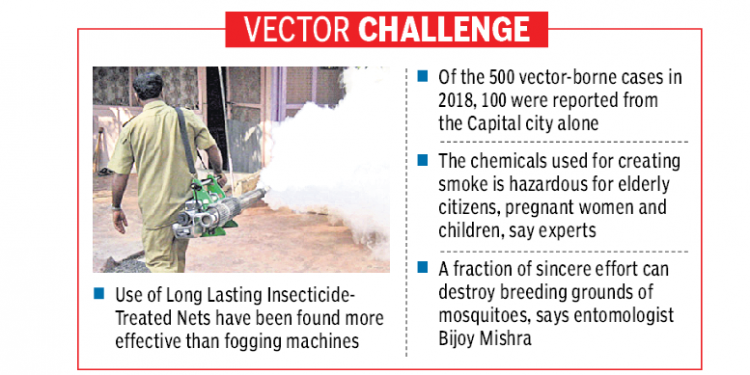Bhubaneswar: With the state and city recording a high number of vector-borne diseases Bhubaneswar Municipal Corporation’s (BMC) lack of sting to deal with the issue has raised concerns with the experts.
According to figures provided by National Vector Borne Disease Control Programme (NVBDCP), Odisha ranked 5th in dengue, malaria and microfilaria cases recorded in 2018.
With about 5000 cases in Odisha this year more than 100 of these were reported from the Capital city. However, what is surprising is that the Bhubaneswar Municipal Corporation is grossly underequipped functioning with only seven fogging machines for 67 wards.
However, Dr. Rama Chandra Rout, senior health officer at BMC reasoned that the mosquito density in the city is comparatively low compared to many other cities in Odisha but the potential danger does lie if their number is not kept under check.
“We fog the areas within two months for two hours in different parts of the city. During the Hockey World Cup we fogged areas near Kalinga Stadium, Biju Patnaik Airport and other key locations of the city. The process was intensified during the breeding season or in areas where such cases were reported,” he added.
The usage of fogging machines, however, has been a subject of debate for environmentalists and health experts. “The chemicals used for creating smoke is hazardous and is harmful to old-age men, pregnant women, underage children and people suffering from respiratory problems,” said environmentalist Pradeep Jena
Fogging machines operational method requires mixing one part of malathion and pyrethrum extract to 19 parts of diesel. Although the NVBDCP suggests blending the insecticide with kerosene the officials prefer diesel due to non-availability of the kerosene.
Entomologist Bijoy Mishra states that the process only satisfies people’s psychology otherwise, it is not of much use. The smoke only affects the adult mosquitoes but the breeding source remains unaffected.
“Mosqitoues are cold-blooded species. When the temperature goes below 10° C, adult females die after depositing their eggs in water-holders or bodies that hatch in warmer weather. Even if a fraction of the effort is concentrated to destroy breeding grounds the cases will drop significantly,” explains Mishra.
Agreeing to this, Chandra said they have to use the fogging machine judiciously. He, however, suggested that usage of Long Lasting Insecticide-Treated Nets (LLINs) have been more effective than fogging machines and have helped bring down about 60 per cent of cases in the city.
However, the suggestions does not seem to mollify Binood Sahoo who resides near Indradhanu Market and has been suffering from filariasis – a disease caused by roundworms or through mosquito bites resulting in massive swelling of legs or affected area.
“I have never seen a fogging machine in my area. Mosquitoes are in our area even during winters. These authorities are only concerned with areas where bureaucrats, ministers or high-profile people live while we continue to suffer,” he complains.
Half A Loaf
European leaders did what they are known to be good at – a brand of diplomacy aimed at antagonizing neither...
Read moreDetails





































